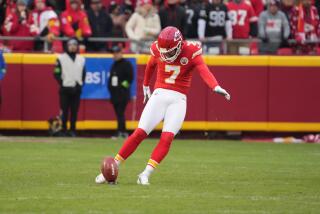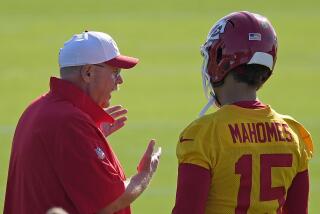Pro Football / Bob Oates : Insiders Look to ‘90s With Financial Hope
Here’s a prediction that some well-informed people in the National Football League are making, at least privately: Financial responsibility and sensibility will come to pro football in the 1990s.
They say that:
--There will be a payroll ceiling, based on a percentage of gross income from all sources, including shared gate revenues.
--There will be a salary scale, based on player efficiency and longevity, plus a form of free agency.
The owners are suddenly in general agreement that ceilings and salary scales are about the only answer to out-of-sight salaries and bonuses.
There is also a consensus that such radical procedural changes can only be implemented in a partnership between owners and players.
Though no owners or club executives will discuss the situation on the record, they don’t talk about much else when they get together these days.
“We’ve got to quit throwing money at players before they earn it,” one influential National Football League owner said. “In the past, teams could afford to throw millions at rookies and free agents--and let the (player) agents raise the ante by millions every year--but those days are over.
“It’s only a matter of time until we’re all broke if we keep this up. We just don’t have enough sources of big, new income. We’ve got to work things out with the (players’ association)--and we’ve got to do it soon.”
The history of player-owner relationships in America shows that income distribution has been uneven and unfair all along in baseball and football.
In the first 70 years of this century, the owners kept most of what money there was. The players were held in a form of bondage by mandatory contract reserve clauses.
The turning point in the early 1970s was a series of lawsuits won by the players leading toward more free agency, fewer reserve-clause restrictions and other benefits.
As a result, in the last 15 years, the scales have tipped in the players’ direction--and they have tipped heavily toward a minority of sometimes undeserving players.
For example, NFL club owners have wasted millions on everything from draft-choice busts to Plan B free agents--the marginal veterans who changed clubs this year.
By definition, Plan B players are those who moved to other clubs when the NFL sought to appease the courts by requiring each team to free all but 37 of its 1988 veterans. The salaries for most Plan B’s are much larger than they were last year--and many of them, after pocketing large bonuses, were cut.
Is this any way to run a football league?
Shouldn’t the veterans who earn the money get it?
In the 1990s, they may.
Percentage of the gross--as a payroll ceiling under which wage scales could be framed--is a concept that was first advanced in the early 1980s by Ed Garvey, who was then head of the NFL union.
The club owners who turned him down after a bitter strike have lost nearly 10 years of financial stability since then--not to mention millions in legal fees and advances to high draft choices who failed.
Garvey sought 55% of the NFL’s gross but would have settled for 50%. Since 1983, when he left the union, the league has actually paid out 58% of its gross to NFL players, according to General Manager George Young of the New York Giants, and other sources.
“The only league that has gone for our idea is the (National Basketball Assn.),” Garvey said from his law office in Madison, Wis., this week. “And that was only because of a far-seeing commissioner, Larry O’Brien (who accepted 53%).
“It’s no coincidence that the NBA has been the nation’s most stable sports league in the 1980s--and also the fastest-growing.”
Most early-season holdouts this year resulted from Plan B irregularities and other salary inequities that wouldn’t have been factors in a wage-scale league.
On opening day, at least two holdouts proved unusually costly to NFL club owners in unsuspected ways.
When the Cincinnati Bengals played without Eddie Brown, they lost to the Chicago Bears by three points.
When the Miami Dolphins played without Mark Clayton, they lost to the Buffalo Bills on the game’s final desperation play.
Along with Jerry Rice, Henry Ellard and Anthony Carter, Brown and Clayton are among the league’s most valuable wide receivers, as most of them proved last Sunday--when Brown and Clayton returned to play instrumental roles in turnabout victories for both teams.
Clayton caught six passes. The first 1989 catch for Brown went for a touchdown.
“You saw what we can do when we have all our weapons,” Cincinnati quarterback Boomer Esiason said.
Except for unnecessary salary fights, Cincinnati and Miami might both now be 2-0.
The Raiders say they have found another football player. He is center Dan Turk, who in Kansas City last Sunday successfully held off one of the league’s most celebrated nose tackles, Bill Maas.
Turk, a free agent in from Tampa was so effective that before Maas was hurt late in the second quarter, his name was mentioned only once by the public address announcer.
“I don’t know why (Turk) didn’t like (Tampa),” Raider executive Al LoCasale said. “But the coaches there liked him. He didn’t just walk in here. We had to compete for him with other clubs.”
Starting a trend, perhaps, some of the league’s better coaches have been going for it on fourth and one this month instead of routinely sending in their field goal teams.
Joe Gibbs of Washington, who is hardly a daredevil, and Sam Wyche of Cincinnati, who is, have both opted for fourth-down running plays occasionally, as have others.
“What’s happening, I think, is that if you don’t have full confidence in your kicker now, you’re telling yourself that you might as well go for it,” said Dick Steinberg, director of player personnel for the New England Patriots.
Under 1989 rules, there are three good reasons to do that:
--The goal posts are 10 yards deeper than they used to be.
--The ball comes back to the line of scrimmage now if you miss.
--Today’s kickers, who are specialists, tend to be inconsistent in clutch situations.
For help on this weighty problem, some coaching staffs are doubtless turning to their computers:
“How often are we scoring after running on fourth and one? What’s our average points per attempted kick? What’s our average points after we go for it?”
The computer knows all. It might show that after a series of fourth-down calls from the 25- or 30-yard line, say, the coach made an average of two points on kicks and four points after running on fourth and one.
If so, that would be good for football. A kick is the dullest play in the game.
More to Read
Go beyond the scoreboard
Get the latest on L.A.'s teams in the daily Sports Report newsletter.
You may occasionally receive promotional content from the Los Angeles Times.










